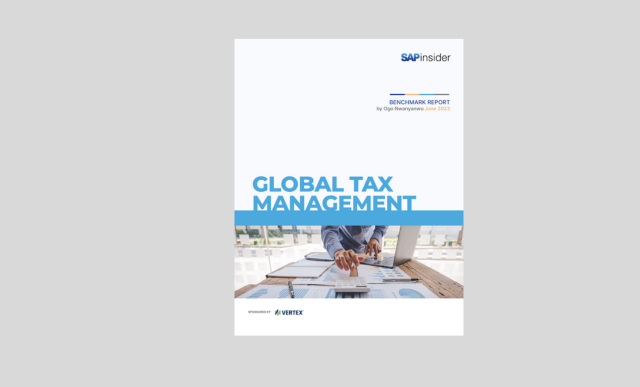Key Technology Investments to Facilitate Indirect Tax: An Expert Interview with Avalara
Key Takeaways
⇨ SAP customers are increasingly prioritizing tax technology investments, with 63% of surveyed tax teams planning to expand their budgets to focus on automation and AI to tackle complex global regulations.
⇨ Integrating tax transformation into SAP S/4HANA projects is essential, as early involvement of tax teams can streamline the process and mitigate data access issues, ultimately minimizing compliance risks and enhancing financial accuracy.
⇨ Organizations should emphasize cloud migration and the clean core principle in customizing SAP solutions to leverage AI and machine learning capabilities for improved tax processes and compliance.
SAP customers are increasingly prioritizing investments in tax technology, focusing on automation, artificial intelligence (AI), and related innovations to address the growing complexity of global regulations and compliance, as revealed in the latest SAPinsider research. According to the recent report, “Tax Technology Innovation and Automation,” 63% of surveyed tax teams plan to expand their budgets for tax technology investments.
To explore these trends further, we spoke with Anders Knox, Strategic Partner Director at Avalara, a leading indirect tax technology provider.
The Growing Momentum for Automation and Innovation
The demand for business process standardization, automation, and innovation continues to rise, with tax processes no exception. According to “The CIO’s 2024 Transformation Report Card,” automation, standardization, and redesign of business processes ranked as the top transformation project for executives, maintaining its position for the second consecutive year.
Explore related questions
“The world is becoming more automated, and tax, as a data-driven process, is an ideal candidate for automation,” says Knox. “Indirect tax involves clear data streams that feed into sophisticated tax calculation engines.”
New regulations, such as e-invoicing requirements that mandate digital tax audit trails, are further driving the need for touchless, fully automated tax processes. Tax teams cannot do their work after the transaction, they need to insert themselves into the transaction without slowing things down. Automation is the only way, Knox explains, “When a customer makes a purchase, you need to calculate the tax in real time, you are often required to report that transaction in real time, later executing reporting and remittance, and Automating these processes minimizes the burden on employees and enhances accuracy.”
Integrating Tax Transformation into SAP S/4HANA Projects
Tax-related investments are often linked to organizations’ broader ERP transformation efforts, particularly migrations to SAP S/4HANA. Multiple SAPinsider studies confirm that SAP S/4HANA remains the top priority for SAP customers, driven by its ability to support AI, automation, and advanced analytics.
This ERP migration presents tax teams with a rare opportunity to integrate tax transformation into the project. However, Knox emphasizes the importance of early involvement: “Transformation can be straightforward if tax teams are included from the start. If not, they risk facing data access issues, requiring costly change orders mid-project.”
To gain a voice in SAP S/4HANA initiatives, Knox advises tax teams to highlight the financial impact of accurate tax management. “For B2C organizations, taxes can account for 7% of revenue—potentially more than their profit margin. Effective tax handling is critical to avoiding penalties and protecting margins,” he explains.
Preparing for AI and Cloud Adoption
Access to AI and machine learning (ML) capabilities is now a must-have for automating and innovating business processes. As SAP increasingly offers these features exclusively on its cloud platforms, customers are accelerating their ERP cloud migrations.
Knox says that while SAP S/4HANA Public seems to be the licensing choice most companies are making SAP S/4HANA Private still services SAP customers that want a greater level of customization. How you do that customization will be key to your AI future. AI requires two things. Clean, meaningful data and a clean ability to act. Because SAP will likely be big piece of your AI future, customizations within the core of SAP put both of those at risk. “That is why we did a clean sheet redo of our integration to S/4HANA Private on BTP to bring the least amount of customizations for a complex indirect tax deployment. All functionality you add to S/4 Private needs to be clean core focused.” advises Knox.
Avalara supports this shift by building its integrations natively on the SAP Business Technology Platform (BTP) and adhering to the “clean core” principle.
Avalara is also leveraging AI for innovation on two fronts: intelligent chatbots that can automatically answer customer queries and AI enabled features within their current solutions that have been created through Avalara’s own internal experimentation.
Breaking Misconceptions and Showcasing Enterprise-Grade Capabilities
Avalara is often misperceived as a tax partner primarily serving small and medium-sized businesses (SMBs). Knox clarifies, “While we had to create a breakthrough in indirect tax usability to bring automation to the SMB space, we serviced SMB’s by being the tax engine behind the largest marketplaces in the world, the scale and sophistication of our solutions exceeds enterprise-level demands.”
To illustrate Avalara’s capabilities, Knox recounts how they reduced an enterprise prospect’s three-day tax obligation process to just 15 minutes, significantly transforming their business operations. “We can do that because we run the world’s best indirect tax calculation engine, asserts Knox.”
What This Means for SAPinsiders
- Secure Tax’s Seat at the Table
The SAP S/4HANA migration is a once-in-a-decade opportunity to reassess tax processes, prepare for AI and advanced analytics, and ensure compliance with evolving global regulations. - Prioritize Tax Master Data
Early planning around data is critical. Delays can result in inaccurate reports, compliance penalties, and increased costs for manual validations. - Think Cloud, Clean Core, and SAP BTP
With SAP’s latest innovations tied to cloud platforms, organizations should carefully assess ERP deployment models and minimize customizations. Explore SAP BTP for seamless integrations while preserving a clean core





